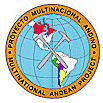
 |
MAP NEWS |
|
Upcoming Activities Volcanology Field Course All reservations have been made, all meal allowances have been tabulated, and all transportation has been coordinated for the volcanology field course of August 10th. We are pleased to be welcoming to Canada for participation in this trip:
Daniel Rubiolo
Also, to add to the volcanological expertise of Cathie Hickson, Patrick Pringle will be accompanying the trip in the U.S. as an expert on Mt. Rainier geology, Kelly Russell will join the trip in Canada as an expert in Coast Mountain volcanism, and Murray Journeay will join the trip in Wells Gray to discuss the structural controls on volcanism. If anyone needs any further information, please contact: Paul Cordy at
Mineral Deposits' Tour
|
|
|
|
Mapping The World with Remote Sensing
The following is an extract from the EOS, transactions, American Geophysical Union, Vol. 79, number 2, January 13, 1998. The article is titled Mapping the World with Remote Sensing by Ahmed Mahmood, John P. Crawford, Rejean Michaud, and Kenneth C. Jezek. It may be of interest to the countries who are using satellite images to aid their research. "The launch of Canada's RADARSAR-1 satellite on November 4, 1995, marked a significant advance in spaceborne microwave remote sensing and a major contribution toward creating a viable international market for remote sensing data." "Compared to previous spaceborne radar images, RADARSAR-1 offers a wide choice of ground resolution, imaging swath width, and incident beam angle. Its ScanSAR beam with 500-km-wide imaging swath and 100-m resolution is well-suited for global -or regional-scalesynoptic observations, and fine beam with 50-km-wide imaging swath and less than 10-m resolution is ideal for local, detailed studies.The data adapts to a variety of land and sea applications." The all-weather imaging capabilities of RADARSAT-1 and its multimode, multiresolution capabilities are, for example, particularly well-suited for monitoring the environment and verifying international protocols for sustainable development and biodiversity. The future data acquisitions will result in special data sets for agriculture, forestry, and mapping applications. This satellite is currently being used in the GLOBESAR Project. |
|
Latin American VMS DepositsGeological Association of Canada (GAC / AGC)
Central and Latin American Volcanogenic massive sulphides (VMS) deposits have emerged from the shadows during the last decade and much new information has become available, with Canadian geologist and mining companies in the vanguard of the search. That is hardly surprising, considering how important this class of deposit has been to the growth of the Canadian mining industry. No compendium of these Latin American deposits exists and a volume dealing with their genesis will further the search for others. The Mineral Deposits Division (MDD) of GAC proposes to introduce and publish such a volume in time for the GAC annual meeting in Calgary in May 2000, where Latin American VMS deposits will be highlighted. The volume is intended to serve MDD members and others working in Latin America by beginning to fill this large blank on world maps of VMS deposits. It will also assist Latin American explorationists to broaden perspectives with respect to these deposits and will underline the important role Canadians are playing in the region. The volume will be self-financed and priced modestly to recover MDD costs in order to make it easily available to all workers and students interested in this deposit class and this region. Besides the English volume, MDD is giving serious consideration to the publication of a Spanish translation. The translated volume cannot be self-financing and must be, therefore, contingent on contributions to defray part of the translation costs. It has been suggested that such contributions be sought from Canadian service, supply and consulting companies active in the region in exchange for prominent acknowledgment of their support. A steering committee composed of the following has been struck to oversee and guide the project:
Dirk Tempelman-Kluit, MDD Publication Chair Dava Jennings, Farallon Art Soregaroli, Vice-President, GAC Peter Tegart, Manhattan John Thompson, Teck Bob Cathro, MDD Treasurer
Ross Sherlock and Roland Bartach (formerly at MDRU) have agreed to serve as co-editors of the volume. MDD intends to work cooperatively with Canadian and other groups engaged in VMS research in the region. The first draft of a proposed Table of Contents is as follows:
- Overview of Cordilleran VMS volcanic belts and their deposits: setting and geology. - Geology of the VMS-hosting volcanic belts of Mexico. - Deposit description of Campo Morado camp, Mexico. - Geophysics of Campo Morado camp, Mexico. - Deposit description of San Nicolas Camp. - Geophysics of San Nicolas Camp. - Deposit description of Rey de Plata deposit. - Deposit description of Tizapa deposit, Mexico. - Deposit description of Parral deposit, Mexico. - Deposit description of Cuale deposits, Mexico. - Deposit description of Comanja de Corona deposits, Mexico. - Deposit description of Francisco de Madero deposits, Mexico. - Deposit description of La Minita deposits, Mexico. - Deposit description of the Leon belt, Mexico. - Geology and setting of VMS deposits in Dominican Republic. - Geology and setting of Bailadores VMS deposits in Venezuela. - Geology and setting of VMS deposits in Colombia. - Geology and setting of VMS deposits in Ecuador. - Geology and setting of Miguela deposit, Bolivia. - Geology and setting of Tambo Grande camp, Peru. - Geophysics of Tambo Grande camp, Peru. - Geology and setting of Cerro Lindo deposit, Peru. - Geology and setting of other VMS deposits in Peru. - Geology and setting of El Aripunana VMS distric, Brazil. - Geology and setting of El Alemao and Pojuca VMS deposits in Brazil. - Geology and setting of Fin del Mundo belt in Argentina. - Geology and setting of VMS deposit in Uruguay.
For more information please contact:
Dr. Dirk Tempelman-Kluit
Mr. Bob Cathro Tel (604) 947-0038. |
|